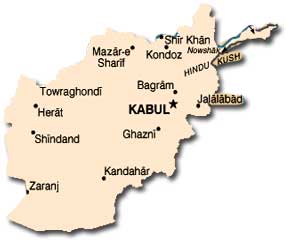Afghanistan: GEOGRAPHY
GEOGRAPHY
Location: Afghanistan is located in Central Asia, north and
west of Pakistan, east of Iran, and south of Turkmenistan,
Uzbekistan, and Tajikistan. The narrow Wakhan Corridor
extends from northeasternmost Afghanistan to meet with
China.
Size: Afghanistan occupies approximately 647,500 square
kilometers, slightly less than Texas.
Land Boundaries: Afghanistan has borders with the following countries: China, 76 kilometers; Iran, 936 kilometers; Pakistan, 2,430 kilometers; Tajikistan, 1,206 kilometers; Turkmenistan, 744 kilometers; and Uzbekistan, 137 kilometers.
Disputed Territory: Afghanistan has no boundary disputes; ongoing incursions, smuggling, and terrorist movement across the Pakistan border are addressed in regular bilateral meetings.
Length of Coastline/Maritime Claims: Afghanistan is landlocked.
Topography: The terrain of Afghanistan is dominated by rugged mountain ranges, which generally run from the northeast to the southwest. Mountains occupy all but the north-central and southwestern regions of the country, which are dominated by plains. Nearly half the country has an elevation of 2,000 meters or more, and the highest peaks in the northeastern Hindu Kush range exceed 7,000 meters. Historically, mountain passes along the northeastern border with present-day Pakistan have been of great strategic importance. Significant parts of the southwestern plains region are desert.
Principal Rivers: The main rivers are the Amu Darya, 800 kilometers; the Harirud, 850 kilometers; the Helmand, 1,000 kilometers; and the Kabul, 460 kilometers. Afghanistan’s chief tributaries to the Amu Darya, which forms much of the country’s northern border, are the Koshk and the Qonduz.

Click to Enlarge Image
Climate: Afghanistan’s climate generally is of the arid or semi-arid steppe type, featuring cold winters and dry, hot summers. The mountains of the northeast have subarctic winter conditions. Farther south, monsoon effects moderate the climate near the Pakistan border and increase rainfall as far inland as central Afghanistan. The highest precipitation occurs in the Kabul region of the northeast. The highest temperatures and lowest precipitation are in the southwestern plains region, where summer temperatures reach 49° C. Low temperatures in the northeastern mountains range from –15° C in winter to 0° C in summer. The climate of the north-central Turkistan Plain is increasingly arid closest to the northern borders with Turkmenistan, Uzbekistan, and Tajikistan.
Natural Resources: Agricultural resources are primarily grazing land; fertile crop-growing land is concentrated in Kondoz Province in the north and Helmand Province in the south. Afghanistan is known to have major deposits of chrome, coal, copper, iron, and salt, as well as lesser amounts of a wide variety of minerals including gold, silver, and uranium. Natural gas is the most abundant hydrocarbon resource. Substantial oil deposits are recognized but not yet quantified. Water for all purposes is in critically short supply.
Land Use: Some 12.1 percent of Afghanistan’s land is classified as arable; however, in the early 2000s a four-year drought cut that figure in half. In 2005 only 0.2 percent of the total was planted to permanent crops.
Environmental Factors: Although little studied before recent times, the environment of Afghanistan is assumed to have been spared large-scale disturbances until the Soviet invasion of 1979. Since that time, however, numerous events have caused severe damage. Afghanistan, which has no appreciable bodies of water, suffers from a limited freshwater supply that makes potable water unavailable to more than half the population. In recent years, groundwater quality has deteriorated because of agricultural and industrial runoff, and water quantity has been diminished by large-scale land clearing and desertification. Because of insufficient water treatment, the incidence of water-borne diseases is very high. Widespread overgrazing, soil erosion, salinization, and waterlogging have reduced agricultural productivity. Although Afghanistan has little industry, particulate pollutants from the Aral Sea and industrial complexes in Iran, Turkmenistan, and Uzbekistan contaminate the atmosphere in northern Afghanistan. Chemical use and physical destruction in recent military conflicts have damaged the environment, and landmines and unexploded shells are residual hazards endangering an estimated 4 million Afghanis in 32 provinces.
Time Zone: Afghanistan is four and one-half hours ahead of Greenwich Mean Time.